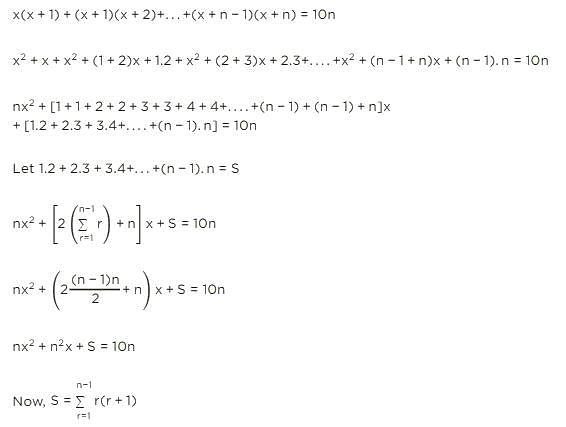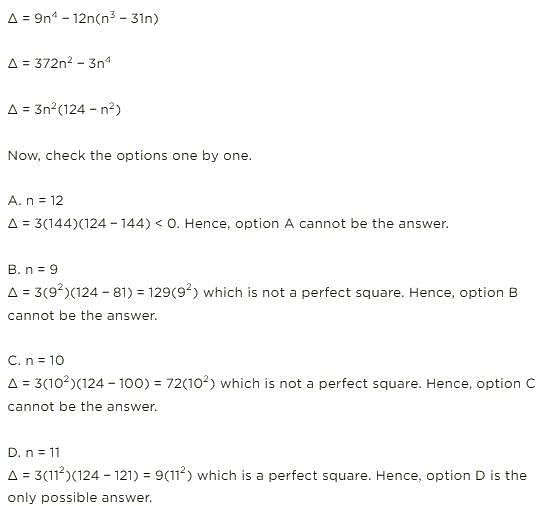CLAT Exam > CLAT Questions > For a positive integern, the quadratic equati...
Start Learning for Free
For a positive integer n, the quadratic equation x(x+1)+(x+1)(x+2)+......+(x+n−1)(x+n)=10 n has two consecutive integral solutions, then n is equal to.
- a)12
- b)9
- c)10
- d)11
Correct answer is option 'D'. Can you explain this answer?
Verified Answer
For a positive integern, the quadratic equationx(x+1)+(x+1)(x+2)+........



Most Upvoted Answer
For a positive integern, the quadratic equationx(x+1)+(x+1)(x+2)+........
Explanation:
Given quadratic equation:
x(x+1) + (x+1)(x+2) + ... + (x+n-1)(x+n) = 10n
Two consecutive integral solutions:
Let the two consecutive integral solutions be m and m+1.
Substitute m and m+1 into the equation:
m(m+1) + (m+1)(m+2) + ... + (m+n-1)(m+n) = 10n
(m+1)(m+2) + (m+2)(m+3) + ... + (m+n)(m+n+1) = 10n
Subtract the two equations:
[m(m+1) + (m+1)(m+2) + ... + (m+n-1)(m+n)] - [(m+1)(m+2) + (m+2)(m+3) + ... + (m+n)(m+n+1)] = 0
This simplifies to: m(m+1) - (m+n)(m+n+1) = 0
Expand and simplify:
m^2 + m - (m^2 + 2mn + n^2 + m + n) = 0
m^2 + m - m^2 - 2mn - n^2 - m - n = 0
- 2mn - n^2 - n = 0
n(2m + n + 1) = 0
Since n is positive:
2m + n + 1 = 0
n = -2m - 1
Since n is an integer:
-2m - 1 must be an integer
This implies that m must be an integer as well.
Therefore, the only value of n that satisfies the condition of having two consecutive integral solutions is when:
n = 11
Hence, the correct answer is option D (11).
Given quadratic equation:
x(x+1) + (x+1)(x+2) + ... + (x+n-1)(x+n) = 10n
Two consecutive integral solutions:
Let the two consecutive integral solutions be m and m+1.
Substitute m and m+1 into the equation:
m(m+1) + (m+1)(m+2) + ... + (m+n-1)(m+n) = 10n
(m+1)(m+2) + (m+2)(m+3) + ... + (m+n)(m+n+1) = 10n
Subtract the two equations:
[m(m+1) + (m+1)(m+2) + ... + (m+n-1)(m+n)] - [(m+1)(m+2) + (m+2)(m+3) + ... + (m+n)(m+n+1)] = 0
This simplifies to: m(m+1) - (m+n)(m+n+1) = 0
Expand and simplify:
m^2 + m - (m^2 + 2mn + n^2 + m + n) = 0
m^2 + m - m^2 - 2mn - n^2 - m - n = 0
- 2mn - n^2 - n = 0
n(2m + n + 1) = 0
Since n is positive:
2m + n + 1 = 0
n = -2m - 1
Since n is an integer:
-2m - 1 must be an integer
This implies that m must be an integer as well.
Therefore, the only value of n that satisfies the condition of having two consecutive integral solutions is when:
n = 11
Hence, the correct answer is option D (11).

|
Explore Courses for CLAT exam
|

|
Similar CLAT Doubts
For a positive integern, the quadratic equationx(x+1)+(x+1)(x+2)+......+(x+n−1)(x+n)=10 nhas two consecutive integral solutions, then n is equal to.a)12b)9c)10d)11Correct answer is option 'D'. Can you explain this answer?
Question Description
For a positive integern, the quadratic equationx(x+1)+(x+1)(x+2)+......+(x+n−1)(x+n)=10 nhas two consecutive integral solutions, then n is equal to.a)12b)9c)10d)11Correct answer is option 'D'. Can you explain this answer? for CLAT 2025 is part of CLAT preparation. The Question and answers have been prepared according to the CLAT exam syllabus. Information about For a positive integern, the quadratic equationx(x+1)+(x+1)(x+2)+......+(x+n−1)(x+n)=10 nhas two consecutive integral solutions, then n is equal to.a)12b)9c)10d)11Correct answer is option 'D'. Can you explain this answer? covers all topics & solutions for CLAT 2025 Exam. Find important definitions, questions, meanings, examples, exercises and tests below for For a positive integern, the quadratic equationx(x+1)+(x+1)(x+2)+......+(x+n−1)(x+n)=10 nhas two consecutive integral solutions, then n is equal to.a)12b)9c)10d)11Correct answer is option 'D'. Can you explain this answer?.
For a positive integern, the quadratic equationx(x+1)+(x+1)(x+2)+......+(x+n−1)(x+n)=10 nhas two consecutive integral solutions, then n is equal to.a)12b)9c)10d)11Correct answer is option 'D'. Can you explain this answer? for CLAT 2025 is part of CLAT preparation. The Question and answers have been prepared according to the CLAT exam syllabus. Information about For a positive integern, the quadratic equationx(x+1)+(x+1)(x+2)+......+(x+n−1)(x+n)=10 nhas two consecutive integral solutions, then n is equal to.a)12b)9c)10d)11Correct answer is option 'D'. Can you explain this answer? covers all topics & solutions for CLAT 2025 Exam. Find important definitions, questions, meanings, examples, exercises and tests below for For a positive integern, the quadratic equationx(x+1)+(x+1)(x+2)+......+(x+n−1)(x+n)=10 nhas two consecutive integral solutions, then n is equal to.a)12b)9c)10d)11Correct answer is option 'D'. Can you explain this answer?.
Solutions for For a positive integern, the quadratic equationx(x+1)+(x+1)(x+2)+......+(x+n−1)(x+n)=10 nhas two consecutive integral solutions, then n is equal to.a)12b)9c)10d)11Correct answer is option 'D'. Can you explain this answer? in English & in Hindi are available as part of our courses for CLAT.
Download more important topics, notes, lectures and mock test series for CLAT Exam by signing up for free.
Here you can find the meaning of For a positive integern, the quadratic equationx(x+1)+(x+1)(x+2)+......+(x+n−1)(x+n)=10 nhas two consecutive integral solutions, then n is equal to.a)12b)9c)10d)11Correct answer is option 'D'. Can you explain this answer? defined & explained in the simplest way possible. Besides giving the explanation of
For a positive integern, the quadratic equationx(x+1)+(x+1)(x+2)+......+(x+n−1)(x+n)=10 nhas two consecutive integral solutions, then n is equal to.a)12b)9c)10d)11Correct answer is option 'D'. Can you explain this answer?, a detailed solution for For a positive integern, the quadratic equationx(x+1)+(x+1)(x+2)+......+(x+n−1)(x+n)=10 nhas two consecutive integral solutions, then n is equal to.a)12b)9c)10d)11Correct answer is option 'D'. Can you explain this answer? has been provided alongside types of For a positive integern, the quadratic equationx(x+1)+(x+1)(x+2)+......+(x+n−1)(x+n)=10 nhas two consecutive integral solutions, then n is equal to.a)12b)9c)10d)11Correct answer is option 'D'. Can you explain this answer? theory, EduRev gives you an
ample number of questions to practice For a positive integern, the quadratic equationx(x+1)+(x+1)(x+2)+......+(x+n−1)(x+n)=10 nhas two consecutive integral solutions, then n is equal to.a)12b)9c)10d)11Correct answer is option 'D'. Can you explain this answer? tests, examples and also practice CLAT tests.

|
Explore Courses for CLAT exam
|

|
Signup for Free!
Signup to see your scores go up within 7 days! Learn & Practice with 1000+ FREE Notes, Videos & Tests.


























